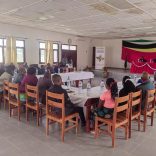Mozambique: Maritime Management Plan is crucial for socioeconomic sustainability
Government announces end to red alert

Notícias
The Mozambican government announced on Tuesday the end of the red alert that was declared in April 2016 in response to the severe drought in the southern and central provinces linked to the El Nino weather phenomenon.
The red alert, the highest state of emergency readiness, was initially declared for 90 days but was then extended to March 2017. The extension was decided by the National Disaster Management Institute (INGC), since by the end of the first 90 days, it had not been possible to obtain the US$204 million needed for assistance.
“We will monitor the situation of food insecurity and evaluate the result of the growing season that ends in March 2017. The combination of these two components will guide whether or not we stay on alert,” explained INGC director general João Machatine last November.
At its weekly meeting on Tuesday, the Council of Ministers (Cabinet), decided to downgrade the state of alert from red to orange, following the rains of this year, which have allowed a recovery in many of the previously drought affected regions.
An orange alert is still regarded as necessary, said the government spokesperson, Deputy Health Minister Mouzinho Saide, since monitoring of the situation will continue “bearing in mind that there are still some foci of concern”.
He stressed that currently enough food is available for the people recovering from the 2016 drought.
As for this year’s stormy weather in the north of the country, Saide said that last week heavy rains hit Nampula province, particularly Mozambique Island and Erati districts. Three people were killed in the storms, and 49 homes were destroyed.
In the far south, Maputo and Matola cities are still facing a critical water shortage. According to a report in Wednesday’s issue of the Maputo daily “Noticias”, restrictions on water supply in Maputo, Matola and the neighbouring district of Boane will continue until at least the start of the next rainy season in October. These restrictions, decreed in January, take the form of pumping water to each district only on alternate days.
Maputo, Matola and Boane are supplied from the water pumping and treatment station on the Umbeluzi river. Under normal circumstances, sufficient water is stored in the reservoir behind the Pequenos Libombos dam on the Umbeluzi, which can hold 400 million cubic metres of water.
But in January, the level of the Pequenos Libombos reservoir fell to just 13 per cent. In the ensuing three months some rain has fallen in the Umbeluzi basin, and the level has recovered somewhat. According to the National Directorate of Water Resources, on Monday the reservoir was about 28 per cent full.
This has allowed an increase in the discharges from the Pequenos Libombos dam from 1.5 to 2.5 cubic metres a second.
But the Mozambican rainy season is now over, and further significant rainfall in the Umbeluzi basin is not likely until October at the earliest. The discharges from the dam are likely to fall back to 1.5 cubic metres a second, or less, in the coming weeks.
The Maputo Regional Water Company (AdeM) is reactivating 22 small scale water systems in Maputo and Matola neighbourhoods where there are productive aquifers. The company says that these systems should be producing water by June.
In addition, six boreholes are being drilled on the slopes overlooking downtown Maputo, on land provided by the Municipal Council. This work too should be completed by June.












Leave a Reply
Be the First to Comment!
You must be logged in to post a comment.
You must be logged in to post a comment.